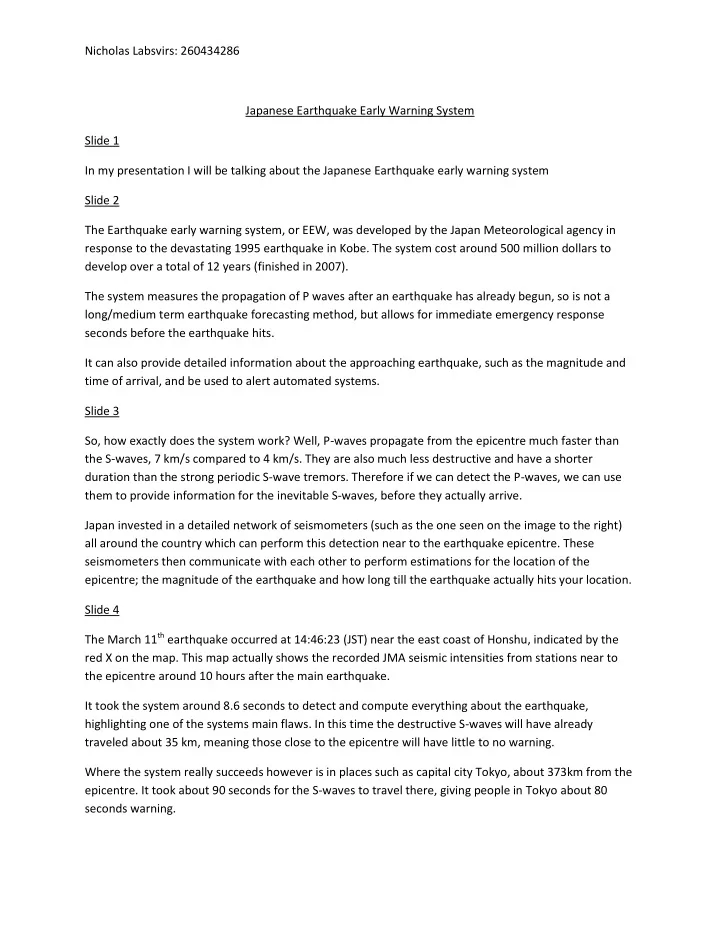

Nicholas Labsvirs: 260434286 Japanese Earthquake Early Warning System Slide 1 In my presentation I will be talking about the Japanese Earthquake early warning system Slide 2 The Earthquake early warning system, or EEW, was developed by the Japan Meteorological agency in response to the devastating 1995 earthquake in Kobe. The system cost around 500 million dollars to develop over a total of 12 years (finished in 2007). The system measures the propagation of P waves after an earthquake has already begun, so is not a long/medium term earthquake forecasting method, but allows for immediate emergency response seconds before the earthquake hits. It can also provide detailed information about the approaching earthquake, such as the magnitude and time of arrival, and be used to alert automated systems. Slide 3 So, how exactly does the system work? Well, P-waves propagate from the epicentre much faster than the S-waves, 7 km/s compared to 4 km/s. They are also much less destructive and have a shorter duration than the strong periodic S-wave tremors. Therefore if we can detect the P-waves, we can use them to provide information for the inevitable S-waves, before they actually arrive. Japan invested in a detailed network of seismometers (such as the one seen on the image to the right) all around the country which can perform this detection near to the earthquake epicentre. These seismometers then communicate with each other to perform estimations for the location of the epicentre; the magnitude of the earthquake and how long till the earthquake actually hits your location. Slide 4 The March 11 th earthquake occurred at 14:46:23 (JST) near the east coast of Honshu, indicated by the red X on the map. This map actually shows the recorded JMA seismic intensities from stations near to the epicentre around 10 hours after the main earthquake. It took the system around 8.6 seconds to detect and compute everything about the earthquake, highlighting one of the systems main flaws. In this time the destructive S-waves will have already traveled about 35 km, meaning those close to the epicentre will have little to no warning. Where the system really succeeds however is in places such as capital city Tokyo, about 373km from the epicentre. It took about 90 seconds for the S-waves to travel there, giving people in Tokyo about 80 seconds warning.
Nicholas Labsvirs: 260434286 Slide 5 How exactly are the warning broadcasted? Well the warnings are broadcasted through as many different media as possible, in order to alert as many people as possible, I have provided a few examples on this slide. The images to the right illustrate a portable household device which provides an audible and visual alert to the earthquake. The first link shows a video of the actual TV alert for the March 11 th earthquake, interrupting a parliamentary broadcast. The second link shows the computer warning system in action, in which a pop up shows the magnitude and epicentre of the earthquake, along with a countdown to the earthquake arrival. Slide 6 In the short period of time before the earthquake actually hits, what effective action can you take? Well little things that can ultimately save lives could be to protect your head and hide under a table. If you are driving in a car, you might want to slow down and pull over so you are stationary when the earthquake arrives (and not on an old/weak looking bridge). If you are outdoors in the street it would be a good idea to look out for falling glass, and avoid any flimsy looking architecture. Slide 7 The system can also be utilised to provide a signal to automated response systems. For example the ATS (Automatic Train Stopping) system uses the EEW system to emergency stop most of japans bullet trains prior to the earthquake, reducing the occurrence of derailing. It is also used to automatically open elevator doors, allowing for people to exit before they can be trapped. For hazard reduction the warning was also used to secure factory assembly lines and alert surgeons in mid surgery. Slide 8 So, was the system actually effective on the March 11 th event? Well, early evidence suggests yes. The most devastation was actually caused by the following tsunami, the initial earthquake responsible for very few deaths. However in the time of preparing this presentation there is no detailed evidence available to prove this. Many other countries have taken notice to Japans state of the art system, a few even installing their own models, for example Mexico, Romania, Turkey and Taiwan all currently have active systems. Other countries are looking into installing similar systems in the near future; these are shown on the map to the right, one close to home being California. This would involve further developing the California Integrated Seismic Network. However this kind of system could cost around $150 million and take up to 5 years to complete so many suggest another large earthquake may have to occur to justify spending that amount.
Nicholas Labsvirs: 260434286 Slide 9 Thanks for listening! Any questions?
Recommend
More recommend